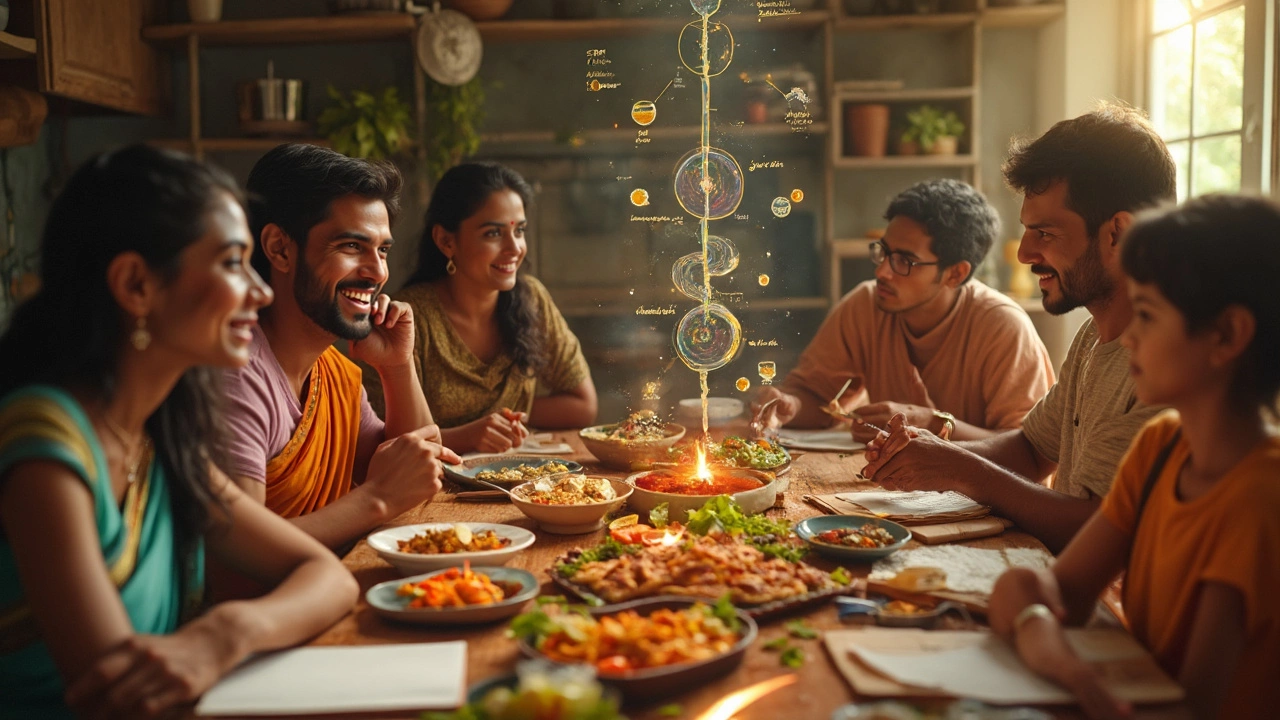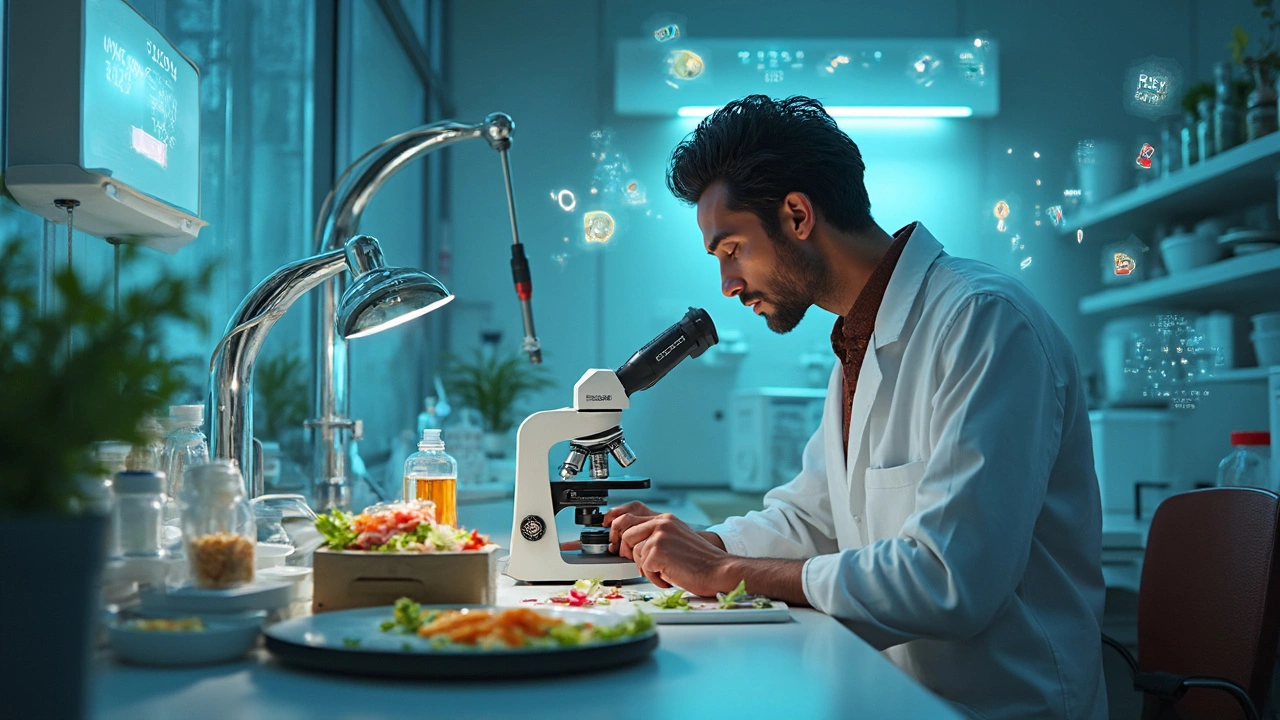What Is the Science of Eating Called?

Ever hear someone throw words like 'nutrition' or 'food science' around and wonder what they even mean? Let’s cut to it: the science of eating is called nutrition science—and trust me, it's about a lot more than just picking out veggies and counting calories.
Nutrition science digs deep into how our bodies use the stuff we eat, why certain foods impact us in strange ways, and even how food is processed before it lands on our plates. It might sound technical, but it sneaks into our lives every day. From deciding what goes in your kid’s lunchbox, to wondering why a bag of chips from the vending machine tastes a certain way, nutrition science has its fingerprints all over it.
The cool part? Science isn’t just watching us eat—it’s actually changing the food itself. Factories use what we know about nutrition and processing to make food safer, longer-lasting, or just tastier. Next time you grab a yogurt and see 'probiotics' on the label, remember those aren’t magic; they’re straight from years of nutrition experiments.
- What's the Name for the Science of Eating?
- How Food Processing Fits In
- Digestion: The Hidden Work
- Everyday Eating and Science
What's the Name for the Science of Eating?
When people talk about the science of eating, they’re usually referring to nutrition science. Some folks might call it nutritional science or just nutrition. The heart of it? It’s figuring out how everything you eat gets broken down, used, or stored by your body. Plus, it looks at what happens when you miss out on certain key nutrients or eat too much of one thing.
Nutrition science isn’t just about personal health. It guides what goes into school lunches, hospital meals, and even astronaut food. Researchers in this field dig into things like how vitamins boost your immune system or how too much processed sugar can set you up for heart problems later.
There are a few major buckets this science covers:
- Macronutrients: Proteins, fats, and carbs—these are what give you calories and energy.
- Micronutrients: Vitamins and minerals that people don’t think about until they’re missing (looking at you, vitamin D in the winter).
- Food Processing: How raw foods get turned into something we actually want to eat, from the farm to your snack drawer.
- Human Digestion: What happens step-by-step from the moment food hits your mouth.
Heads up—nutrition science gets mixed up with other fields, like food technology (how we make and preserve food) and dietetics (figuring out what everyone from athletes to my son Miles should eat to stay healthy). All these overlap, but nutrition science is the big umbrella that pulls it all together. Next time you hear someone ask, “Is this healthy?” what they really want to know is: What does nutrition science say about it?
How Food Processing Fits In
Food processing is way more than just canning veggies or freezing pizza. It’s about taking raw ingredients and making them safe, tasty, and long-lasting. Without it, we'd be chewing on raw grains and worrying about food poisoning way more often than anyone wants to imagine.
Look at your kitchen — you're technically a mini food processing unit yourself when you chop, cook, blend, or even just wash produce. Industrial processing just takes it to the next level. Companies use machines and clever tricks learned from food science to keep flavors locked in, kill off germs, and make sure food can survive the trip from the factory to your table.
Some classic processing methods you use every day include:
- Canning soups and sauces to keep them fresh for months
- Pasteurizing milk to kill off bacteria (so you don’t get sick)
- Freezing veggies so you’ve always got something green for dinner
- Baking and drying snacks so you can pack them without a mess
Think food processing just means junk food? Not really. Most of the time, it’s about safety and convenience. For example, millions of people swear by frozen berries for smoothies — freezing locks in nutrients, and you aren’t stuck with soggy old fruit. The same goes for enriched bread, which often has added vitamins to boost nutrition.
Let’s check out some quick stats that show how important food processing is in the modern world:
| Fact | Data |
|---|---|
| Percent of US foods processed in some way | ~70% |
| Food-related illnesses prevented by pasteurization annually | Estimated 100,000+ |
| Time produce stays edible after freezing | Up to 12 months |
| Common vitamins added in processed foods | Vitamin D, Iron, B12 |
Bottom line: food processing is a real lifesaver — literally. It isn’t always obvious, but every jar, package, or bag you pick up has a mix of nutrition smarts and factory know-how behind it. That’s how we keep food safe, tasty, and available year-round, even when apples aren’t in season.

Digestion: The Hidden Work
Most folks don’t think much about what happens to food after swallowing, but honestly, this is where the real magic kicks off. Digestion is your body’s behind-the-scenes worker, breaking down that sandwich into stuff your cells can use. Right from the moment you chew, the process is in full swing. Saliva starts breaking down starch, so your body already gets a head start before food even reaches your stomach.
Once food hits your gut, acids and enzymes do most of the heavy lifting. Think of your stomach as a blender mixed with a chemistry set, grinding and dissolving everything. After that, your small intestine grabs nutrients and sends them right into your blood. If you’ve ever wondered why eating too fast gives you heartburn or a stomachache, it’s because this system likes time to work—slow, mindful eating helps quite a bit.
Want to know what really happens to the stuff you eat? Check out this quick table:
| Digestive Organ | Main Job | Time Spent (on average) |
|---|---|---|
| Mouth | Starts breaking down starch, mixes food with saliva | Seconds to 1 minute |
| Stomach | Breaks down proteins, churns & mixes food | About 2-4 hours |
| Small Intestine | Absorbs nutrients into bloodstream | 3-6 hours |
| Large Intestine | Absorbs water, forms waste | 10-24 hours |
Here’s a fun fact: nearly 100 trillion bacteria in your gut help with digestion. They even produce vitamins you can’t make on your own. Mess with your gut bacteria (like taking antibiotics when you don’t need them), and your digestion can get totally out of whack.
If you want to keep your nutrition on point, think about including fiber; it’s the part of plant foods that helps things move through your system and feeds those good gut bugs. Getting enough water also helps your body break down and use what you eat. Digestion might be hidden, but if you treat it right, you’ll feel the difference every day.
Everyday Eating and Science
It's easy to overlook how much science creeps into your daily meals. Every time you throw together a sandwich, science has already played its part, from how bread is baked to how cheese is aged and packaged. The way you eat, and what you eat, comes straight from years of research in nutrition and food processing. We’re not just talking fancy cooking shows. Even grabbing a pre-packed salad from the supermarket involves a lot of science to keep it fresh and safe.
The People’s Pantry 2024 report showed that nearly 77% of shoppers check nutrition labels now, a jump from 62% in 2018. Why the spike? Folks want to compare sugar, fat, and fiber so they can make real choices, not guesses. Parents like me? We're always sneaking peeks at sodium and additives before tossing snacks in the cart for the kids.
| Food Choice | Science in Action |
|---|---|
| Whole Grain Bread | Enriched with extra vitamins, tested for shelf stability |
| Yogurt | Contains live cultures studied for gut health |
| Frozen Veggies | Quick-blanched to keep nutrients intact |
| Sports Drinks | Balanced with electrolytes through lab tests |
A tip from sports dietitian Nancy Clark:
"Food isn’t just fuel—it’s information for your body. The right mix of nutrients can change how you feel and perform day to day."Science doesn’t just tell you what to eat, it helps you know when and why. For example, eating carbs after a workout? There’s research showing it helps your muscles recover faster.
If you want to make smarter eating choices, think practically: read labels, check expiration dates, and watch portion sizes. Don’t fall for every label that shouts ‘natural’ or ‘organic’ without reading the fine print. Real science is about details, not hype. Next time you eat, remember—your choices are backed by years of research and a few hardworking food scientists behind the scenes.